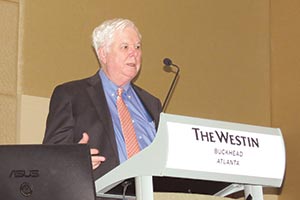Managing Editor, Features and Multimedia
Expected Surge in ELD Demand Could Lead to Messy Rollout

This story appears in the Nov. 21 print edition of Transport Topics.
ATLANTA — The upcoming federal electronic logging device mandate will spur a dramatic increase in technology adoption next year, but implementation could be messy as many carriers continue to wait as long as possible before installing the devices, analysts and technology vendors said.
The ELD mandate will drive “truly hockey-stick growth” in the trucking telematics sector, analyst Clem Driscoll said here Nov. 15 during the annual Connected Fleets USA conference hosted by TU Automotive.
He estimated that the industry will deploy more than 1 million ELDs in the United States next year to comply with the regulation, which will require trucking companies to move from paper logbooks to electronic logs to record drivers’ hours of service by Dec. 18, 2017.
Although the Federal Motor Carrier Safety Administration issued its final ELD rule nearly a year ago, demand for ELDs thus far “has been pretty limited,” said Driscoll, who is president of research and consulting firm C.J. Driscoll & Associates. “Most small fleets and owner-operators appear to be in no rush.”
Some may have been awaiting the outcome of a lawsuit filed by the Owner-Operator Independent Drivers Association seeking to overturn the rule. A federal appeals court upheld the mandate Oct. 31, denying OOIDA’s challenge.
Meanwhile, as the time left for carriers to deploy ELDs dwindles, questions arise about whether technology providers will be able to meet the surge in demand expected in late 2017, Driscoll said.
He also predicted that some carriers who oppose the mandate may risk operating without an ELD after the compliance date “just to see what happens.”
While most large fleets already have implemented electronic logging, adoption rates are much lower among smaller carriers, many of which likely will wait until December 2017 to install the devices, said Fred Fakkema, vice president of compliance at Zonar Systems, a Seattle-based telematics provider.
That rush to install ELDs at the very end of the implementation period will be “extremely difficult” for the industry to manage, he said, adding that the move to ELDs also will be a challenge from an enforcement standpoint.
“It’s going to be a mess,” when carriers begin transferring data at roadside, Fakkema warned, because many enforcement officers haven’t received training on ELDs and don’t yet understand the rule.
As the industry works its way through that transition, Fakkema encouraged fleets that are using today’s electronic logging technology — known as automatic onboard recording devices, or AOBRDs — to continue using those devices until 2019 before updating their systems to meet the ELD specifications. The ELD rule gives early adopters of AOBRDs an additional two years to comply with the new device standards.
Under the ELD rule, business models based on skirting the hours-of-service regulation will become “unsustainable,” said Rich Alborn, a product manager at Continental Automotive Systems, which offers the VDO RoadLog electronic logging system.
To address the compliance needs of late-stage adopters, many startup companies will continue to enter the market with low-cost ELD products in the coming year, Alborn said. Some of those startups, however, likely will go out of business, which could create trouble for potential fleet customers who still will be responsible for maintaining a compliant ELD, he said.
While some carriers and owner-operators see the ELD mandate as a burden, it also is an opportunity for them to “expand [their] horizons in terms of in-cab efficiency,” said Chris Koszarsky, director of engineering at Garmin.
ELDs can enable additional features such as routing and navigation and productivity tools that can enhance carriers’ operations beyond mere compliance with the regulation and give them a return on their investment, he said.
While truckers can comply with an ELD-only device, many carriers use in-cab communications units that provide ELD functions among many telematics features.
While ELDs likely will be the dominant topic of 2017, Driscoll pointed to merger and acquisition activity as another major trend in the telematics sector in 2016.
He said Verizon Telematics’ recent acquisitions of Fleetmatics and Telogis represent the most significant market consolidation event in the history of the commercial telematics industry.
Those purchases gave Verizon about 24% of the total installed base of U.S. GPS fleet management systems, including 33% market share in local delivery and government fleets, Driscoll said.
He also cited Continental’s recently announced agreement to purchase a controlling stake in Zonar to expand its telematics offerings.
Earlier this year, video telematics provider Lytx Inc. was acquired by private equity firm GTCR for more than $500 million.
Driscoll said Lytx’s success has been attracting new entrants into the video telematics market, including established technology suppliers such as PeopleNet and Omnitracs.
Meanwhile, heavy-duty truck makers have introduced their own telematics services to support remote diagnostics, another trend contributing to the growth of fleet tracking technology.




